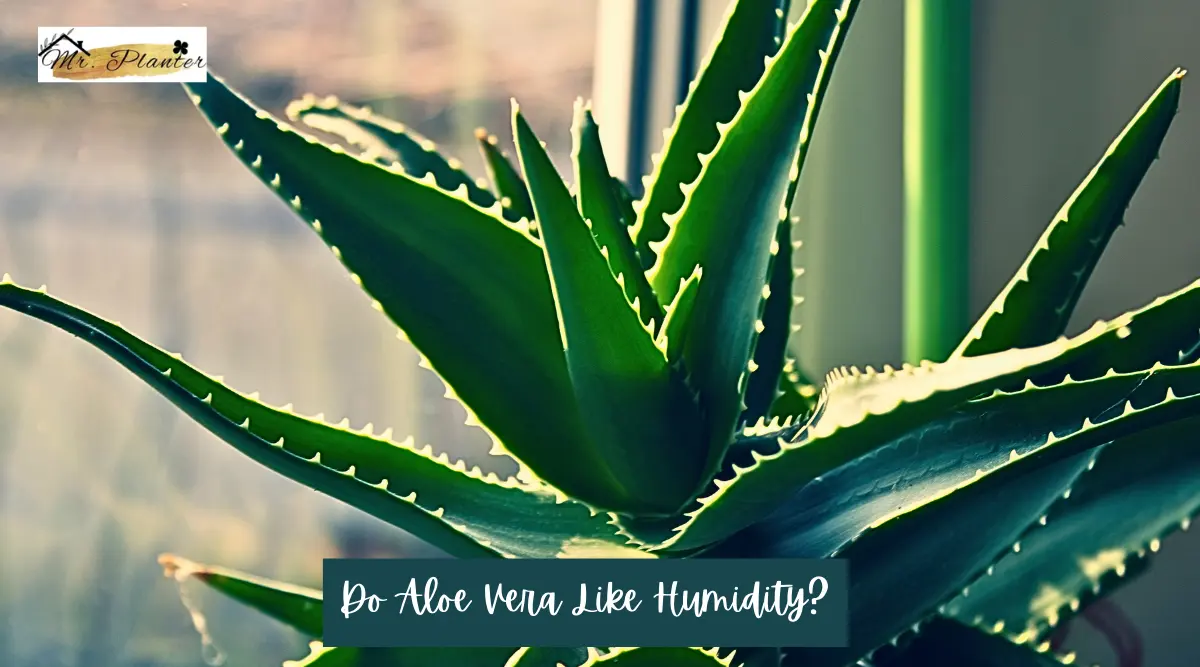Aloe Vera is a very hardy succulent and is very popular. When I first thought about planting an Aloe Vera, I thought about its ideal requirement.
I have tested each of its requirements to help it grow properly. Here I will discuss Aloe Vera’s actual humidity need.

Do Aloe Vera Like Humidity?
Aloe Vera plants can stay in moderate humidity conditions with an average humidity level of 40-50%.
However, the plant may face problems like rotting if the humidity is high. This is because high humidity levels can cause the soil to remain wet for too long, leading to root rot.
Therefore, providing proper drainage and avoiding overwatering your Aloe Vera plant is important.
If you live in an area with low humidity or dry air, your Aloe Vera plant will be perfectly fine. However, if you live in an area with higher humidity levels, you may want to monitor the humidity using a hygrometer. Ideally, Aloe Vera plants prefer low humidity, in the range of 20-30%.
What is the Ideal Humidity for Aloe Vera?
The ideal humidity level for Aloe Vera plants is between 40-50%.
Humidity plays an important role in the growth and development of Aloe Vera plants. If the humidity is too high, the plant may start to rot.
On the other hand, if the humidity is too low, the leaves may turn brown and dry out. Therefore, it is important to monitor the humidity level and maintain it within the ideal range.
Does Aloe Vera Need High Humidity?
Aloe Vera does not need high humidity. Its ideal humidity requirement of 40-50% is quite a moderate amount.
This amount of humidity you will find available in most places. And, if your area’s humidity is much lower than this you can increase it to make it match the ideal humidity requirement.
Tips to Maintain Ideal Humidity of Aloe Plant
To maintain the ideal humidity level for your Aloe Vera plant, you can follow these tips:
- Keep the plant in a well-ventilated area with good air circulation.
- Avoid misting the plant or placing it in a humid environment.
- Use a well-draining soil mix to prevent water from accumulating in the soil.
- Water the plant only when the soil is completely dry.
- Use a terra-cotta pot, which releases excess moisture easily.
How to Reduce the Humidity around Aloe Vera?
If you live in a humid area, you may need to reduce the humidity around your Aloe Vera plant to prevent problems like brown leaves or rotting.
Here are the ways to reduce Humidity:
1. Use a Dehumidifier
One of the most effective ways to reduce humidity around your Aloe Vera plant is to use a dehumidifier.
A dehumidifier is a device that removes moisture from the air, which can help to reduce the humidity level in your home. You can place a dehumidifier near your Aloe Vera plant to help reduce the humidity around it.
2. Improve Air Circulation
Another way to reduce humidity around your Aloe Vera plant is to improve air circulation.
Good air circulation can help to reduce humidity levels by allowing moisture to evaporate more quickly. You can improve air circulation by placing a fan near your Aloe Vera plant or by opening windows and doors to allow fresh air to circulate.
3. Keep the Soil Dry
To reduce humidity around your Aloe Vera plant, it’s important to keep the soil dry.
Overwatering can lead to excess moisture in the soil, which can contribute to higher humidity levels.
Make sure to water your Aloe Vera plant only when the soil is dry to the touch.
Importance of Low Humidity for Aloe Vera Plants
If you have an Aloe Vera plant, you might be wondering how to take care of it properly. One important factor to consider is the humidity level around the plant.
Aloe Vera plants prefer low humidity levels, and it’s important to maintain them to keep the plant healthy.
- Native Environment Adaptation: Aloe Vera plants are native to arid regions, and they are adapted to thrive in low-humidity conditions.
- Preventing Root Rot: Excessive humidity can lead to root rot, a potentially fatal condition. Root rot occurs when the soil stays too moist for too long, causing the roots to rot. High humidity inhibits moisture evaporation, worsening the issue.
- Avoiding Overwatering: Overwatering is a common problem that can contribute to root rot. Ensure the soil dries out completely between watering sessions to prevent overwatering.
- Mold and Rot Prevention: High humidity can promote mold growth on the plant’s leaves, leading to discoloration. It can also result in leaf rot, causing them to become mushy and fall off.
Frequently Asked Questions
What is the ideal moisture level for Aloe Vera?
Aloe Vera plants prefer dry conditions and do not require frequent watering. Overwatering can lead to root rot, which can be fatal. The ideal moisture level for Aloe Vera is between 40% and 60%. It is important to allow the soil to dry out completely before watering again.
Can Aloe Vera survive in high humidity?
While Aloe Vera plants prefer dry conditions, they can survive in high humidity. However, if the humidity is too high, it can lead to fungal diseases and root rot. It is important to ensure proper ventilation and avoid overwatering if the plant is in a high-humidity environment.
Is misting beneficial for Aloe Vera?
Misting Aloe Vera plants can be beneficial, especially in dry environments. However, it is important to avoid misting too frequently as it can lead to fungal diseases and root rot. It is recommended to mist the plant once a week or when the soil is dry to the touch.
Can Aloe Vera be placed in a bathroom?
Aloe Vera plants can be placed in a bathroom as long as they receive adequate light and are not exposed to extreme temperature fluctuations. Bathrooms can be humid, which can be beneficial for the plant, but it is important to ensure proper ventilation to prevent fungal diseases.

